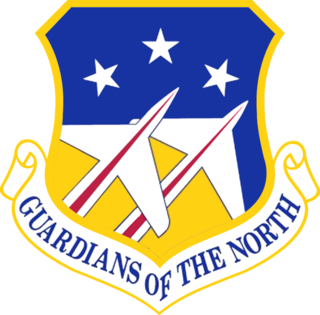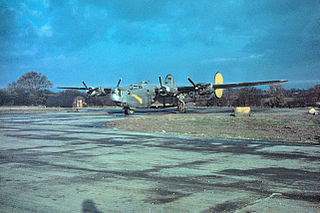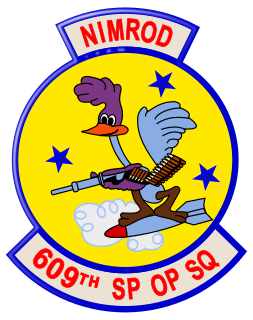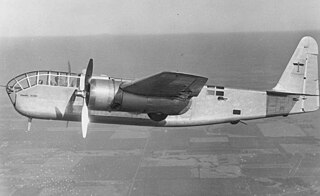| Army Air Forces Tactical Center | |
|---|---|
| Active | 1942–2012 |
| Country | United States of America |
| Branch | United States Army Air Forces |
| Role | Professional Military Education |
| Commanders | |
| Notable commanders | Brig Gen Hume Peabody |
The Army Air Forces Tactical Center was a major command and military training organization of the United States Army Air Forces during World War II. It trained cadres from newly formed units in combat operations under simulated field conditions around which new combat groups would be formed. It was established as the Army Air Forces School of Applied Tactics (AAFSAT) in 1942 and redesignated the following year.
In addition to its training function, the school also developed as a tactical doctrine development center, assuming the functions formerly assigned the Air Corps Tactical School. In June 1946, the center became the Army Air Forces Proving Ground Command.
As the threat of entry of the United States into World War II increased, the United States Army decided to close the Air Corps Tactical School in 1940 in order to use its experienced personnel at headquarters, and in expanded training and tactical units. As a result, the responsibility for the development and change to tactics for Air Corps units was scattered among various Air Corps units. Moreover, no single element of the Air Staff or special committee was responsible for overseeing tactical doctrine for the Army's air elements. [1] The field organizations primarily responsible for development of tactics and associated doctrine were the Army Air Force Board, the Air Defense Board, the Fighter Command School and the Army Air Forces Proving Ground. [2] In addition, the splitting of existing combat groups into cadres for new groups had become impracticable as the number of new groups increased. At the entry of the United States into World War II on 7 December 1941, the Army Air Forces (AAF) had expanded to 67 groups from a pre-1939 total of 15, but approximately half were paper units just forming. The entry into the war meant an immediate significant increase in the numbers of new combat groups, expanding to 269 groups by the end of 1943.
Headquarters USAAF originally intended that four tactical schools be developed across the United States, one each for air defense, air service, air support and bombardment. However "to save administrative costs and physical outlay" [3] and to facilitate coordination between the schools, all four would be consolidated at a single location. Orlando Army Air Base, Florida was chosen 1 November 1942, primarily because it was already the location of Fighter Command School, which would be subordinated to the Army Air Forces School of Applied Tactics (AAFSAT). The AAF determined this organization would conduct tactical development and training and provide tactical training for flyers who were preparing to deploy to theaters of operation. [4] The commandant of AAFSAT was Brigadier General Hume Peabody, formerly the assistant commandant of the Air Corps Tactical School.
The Fighter Command School became AAFSAT's Air Defense Department at once. The 91st Service Group at Fort Dix Army Air Field moved to Orlando and became the Air Service Department. 5th Interceptor Command moved from San Francisco and became the Interceptor Command School. [note 1] The other two departments, Air Support and Bombardment were built up from scratch [5] AAFSAT was organized into three directorates: Tactical Development, School Activities, and Demonstration Air Force, with three combat groups acting as both school units and demonstration air force units. The Directorate of School Activities was responsible for the four functional departments.
The school officially opened 12 November 1942. An important component was the Army Air Forces Board, which supervised developmental projects. This board also assigned developmental projects to AAFSAT's departments, and had two subordinate boards, the Air Defense Board and, after April 1943, the AAF Equipment Board. Although the Board had been operating before AAFSAT was activated, it only became official in July, when the school became the AAF Tactical Center. It was reassigned from the center directly to Headquarters, AAF in October 1943.although the commandant of the center remained a member of the board. [6]
In October 1943, AAFSAT was reorganized and became the Army Air Forces Tactical Center. [4] A "new" AAFSAT was organized as one of the center's subordinate units. The first group receiving AAFSAT training to deploy overseas was the 390th Bombardment Group in July 1943, based in England with the Eighth Air Force. By September 1945, the AAF Center had trained 54,000 personnel and the cadres of 44 bombardment groups.
During 1943-1945 the AAF Tactical Center operated a combat simulation facility in Florida. Units and airfields were established throughout an 8,000-square-mile (21,000 km2) area of north central Florida designated a mock "war theater" stretching roughly from Tampa to Titusville to Starke to Apalachicola in which war games were conducted. AAFSAT also had a bombing range at Ocala AAF, a service center at Leesburg AAF, and an air depot at Pinecastle Army Air Field.
Due to a major reorganization of the Tactical Center and a change in the types of courses conducted by the institution, the Army Air Forces redesignated the "new" AAFSAT as the Army Air Forces School on 1 June 1945, while the Tactical Center dropped the "Tactical" from its name and became the AAF Center. Following the end of World War II, in preparation for its post-war educational operations, the AAF moved the AAF School from Orlando to Maxwell Field, Alabama on 29 November 1945 and assigned it directly to Headquarters, AAF. [7] Having lost its developmental function, the AAF Center moved to Eglin Field in March 1946 and became the Army Air Forces Proving Ground Command. [8]
The AAF Tactical Center medium and heavy bomber school unit from 31 October 1942 was the 9th Bombardment Group. [9] In February 1943, a close air support school unit, the 415th Bombardment Group was added. [10] The fighter school unit from 23 March 1943 was the 50th Fighter Group. [11] Night Fighter training initially began with the 50th Group's 81st Fighter Squadron, but by 1943 was concentrated in the 481st Night Fighter Operational Training Group.
However, the AAF was finding that standard military units like these groups, based on relatively inflexible tables of organization not well adapted to the training mission. Accordingly, it adopted a more functional system in the spring of 1944 in which each base was organized into a separate numbered unit. [12] In preparation for this reorganization, the 9th Bombardment Group moved to Nebraska, where it was reassigned to Second Air Force to become a Boeing B-29 Superfortress unit. [9] [note 4] The 50th Fighter Group began to concentrate on training in preparation for deployment to the European Theater of Operations in March 1944, the 481st Night Fighter Operational Training Group continued its mission, but transferred to Fourth Air Force in California in January 1944. The transition to the new organization took place on 14 April 1944.
With a ground school at Orlando Army Air Base, Florida, presenting a two-week academic course, AAFSAT also taught a two-week field course utilizing eleven training airfields in Florida representing all conditions likely to be found in combat, from bare fields to prepared bomber air bases having 10,000-foot (3,000 m) runways.

The 85th Group is an inactive United States Air Force organization. Its last assignment was with United States Air Forces in Europe at Naval Air Station Keflavik, Iceland, assigned as a unit of the 48th Fighter Wing whose home station is at RAF Lakenheath, UK. It was inactivated on 28 June 2006.

The 81st Fighter Squadron is a flying squadron of the United States Air Force. It is Geographically Separated Unit of the 14th Flying Training Wing at Columbus Air Force Base, Mississippi, and operates the A-29B Super Tucano aircraft conducting close air support training to the Afghan Air Force as part of ISAF. It is stationed at Moody Air Force Base, Georgia.

The 128th Airborne Command and Control Squadron is a unit of the Georgia Air National Guard 116th Air Control Wing located at Robins Air Force Base, Georgia. The 128th is equipped with the E-8C Joint STARS.

The 348th Night Fighter Squadron is an inactive United States Air Force unit. Its last assignment was with the 481st Night Fighter Operational Training Group, based at Salinas Army Air Base, California. The unit was inactivated on 31 March 1944.

The 496th Tactical Fighter Squadron is an inactive United States Air Force unit, last assigned to the United States Air Forces in Europe, 50th Tactical Fighter Wing, being stationed at Hahn Air Base, Germany. The squadron was inactivated on 15 May 1991.

The 445th Flight Test Squadron was a United States Air Force squadron. It was last assigned to the 412th Operations Group at Edwards Air Force Base, California, where it performed flight testing on General Dynamics F-16 Fighting Falcon. The 445th was part of the Air Force Test Center. It formulated test programs, developed the criteria for and executed flight test missions, analyzed data from the test flights and reported on the results.

The 847th Bombardment Squadron is a former United States Army Air Forces unit that was originally activated as the 421st Bombardment Squadron. Its last assignment was with the 489th Bombardment Group at Great Bend Army Air Field, Kansas where it was inactivated on 28 March 1945. As the 20th Antisubmarine Squadron, the squadron performed antisubmarine patrols in 1942 and 1943. After reforming as a heavy bomber squadron, it engaged in the strategic bombing campaign against Germany in the European Theater of Operations until returning to the United States in late 1944. The squadron was inactivated while its parent group was training as a very heavy bombardment unit.

The 84th Combat Sustainment Group is an inactive United States Air Force (USAF) group last assigned to the 84th Combat Sustainment Wing at Hill Air Force Base, Utah, where it was inactivated in 2010. The group was formed in 1942 as the 84th Bombardment Group, one of the first dive bomber units in the United States Army Air Corps and tested the Vultee Vengeance, proving that aircraft unsuitable as a dive bomber. As an Operational Training Unit, it was the parent for several other bombardment groups, but from 1943 until it was disbanded in 1944, trained replacement aircrews as a Replacement Training Unit designated the 84th Fighter-Bomber Group.

Alachua Army Airfield, was a World War II United States Army Air Force airfield, located 4.2 miles (6.8 km) northeast of Gainesville, Florida.

The 609th Special Operations Squadron is an inactive United States Air Force unit. Its last assignment was with the 56th Special Operations Wing at Nakhon Phanom Royal Thai Navy Base, Thailand. The squadron served for two and a half years combat duty during the Vietnam War, primarily flying missions over the Ho Chi Minh Trail in Laos. It earned several decorations, including the Presidential Unit Citation, before it was inactivated in December 1969.

Keystone Army Airfield, was a World War II United States Army Air Forces airfield, located 4.2 miles (6.8 km) north-northwest of Keystone Heights, Florida.

The 411th Bombardment Group is an inactive United States Army Air Forces unit. Its last assignment was with III Bomber Command at Florence Army Air Field, South Carolina, where it served as a Replacement Training Unit until it was disbanded on 1 May 1944. In July 1985, the group was reconstituted as the 411th Tactical Missile Wing, but has never been active under that name.

The 349th Night Fighter Squadron is an inactive United States Air Force unit which specialized in training airmen to utilize night fighters as nighttime interceptors. Its last assignment was with the 481st Night Fighter Operational Training Group, based at Hammer Field, California. First activated in October of 1942, the unit was inactivated on 31 March 1944.

The 465th Tactical Training Squadron is an inactive United States Air Force unit. During World War II as the 465th Bombardment Squadron, it was an operational and replacement unit from 1942 to 1944, when it was disbanded in a general reorganization of Army Air Forces training and support units in the United States. The squadron was reconstituted as the 465th Tactical Fighter Training Squadron in 1973 and briefly operated the General Dynamics F-111 Aardvark at Cannon Air Force Base, New Mexico. It moved to Holloman Air Force Base, New Mexico and operated as a fighter and academic training unit until inactivating in 1991.

The 915th Air Refueling Squadron is an inactive United States Air Force unit. It was last assigned to the 72d Bombardment Wing at Ramey Air Force Base, Puerto Rico where it was inactivated on 30 June 1971 when the Air Force transferred Ramey to Military Airlift Command.

The 839th Bombardment Squadron is an inactive United States Army Air Forces unit. It was activated in January 1941 as the 79th Bombardment Squadron and equipped with Douglas A-20 Havoc light bombers. Following the attack on Pearl Harbor the squadron began to fly antisubmarine patrols off the Atlantic coast and over the Caribbean Sea, becoming the 8th Antisubmarine Squadron.

Kissimmee Army Airfield, was a United States Army Air Forces airfield during World War II, located 1.8 miles (2.9 km) west of Kissimmee, Florida.

The 1st Proving Ground Group is a disbanded United States Army Air Forces unit. It was last active with the Army Air Forces Proving Ground Command, based at Eglin Field, Florida, where it was disbanded on 1 April 1944. The unit's personnel/equipment/mission was taken over by the 610th Army Air Forces Base Unit and 611th AAF Base Unit.

Operational Training Units (OTU) and Replacement Training Units (RTU) were training organizations of the United States Army Air Forces during World War II. Unlike the schools of the Army Air Forces Training Command (AAFTC), OTU-RTU units were operational units of the four domestic numbered air forces along with I Troop Carrier Command and Air Transport Command, with the mission of final phase training new pilots or crews. Most were disbanded in the Spring of 1944 and replaced by combat crew replacement centers assigned to base units.

The 481st Night Fighter Operational Training Group was a unit of the United States Army Air Forces. It was inactivated on 31 March 1944 at Hammer Field, California.
![]() This article incorporates public domain material from the Air Force Historical Research Agency website http://www.afhra.af.mil/ .
This article incorporates public domain material from the Air Force Historical Research Agency website http://www.afhra.af.mil/ .
|volume= has extra text (help)|volume= has extra text (help)